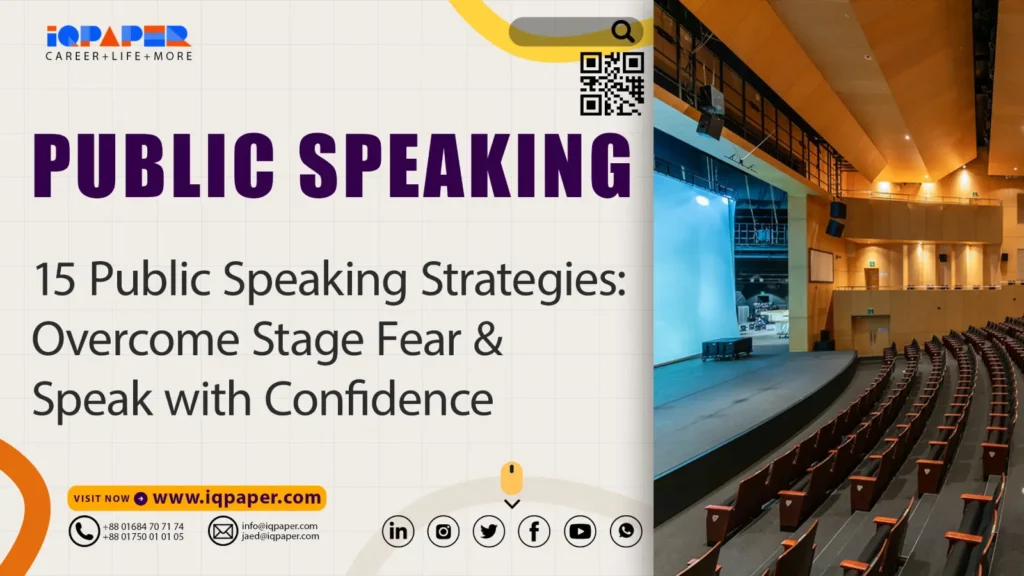What do people fear the most?
It’s not death—it’s public speaking.
This common fear of public speaking is known as glossophobia, and it affects millions. From my early childhood, I was an introvert who struggled to speak—even with close relatives. I used to avoid eye contact and panicked when asked to say a few words in public. Some people may not fear public speaking naturally, but all it takes is one humiliating moment or a bad experience to develop anxiety around it.
But here’s the truth: the only way forward is to conquer it. I’ve done it, and in this article, I’ll share the exact strategies that helped me go from silent to confident.
✅ Are Public Speakers Born or Made?
The best public speakers weren’t born with the skill. They learned it—step by step. After extensive research and personal trial-and-error, I discovered powerful public speaking techniques that actually work.
Let’s break them down.
👣 Entering the Room with Presence
- Don’t rush.
- Avoid fidgeting or showing nervous body gestures.
- Walk in calmly, pause, and make eye contact.
Try the Triple Five Rule:
👁️ Scan 5 faces
⏱️ Hold eye contact for 5 seconds
💬 Connect before speaking
Pro tip: Your body should say, “I’ve done this before.”
🙌 Before You Begin Speaking
- Keep your hands visible. Don’t put them in your pockets.
- Let your hands rest gently near your belly when not using them.
- Use open palms—they signal honesty and trust.
- Smile gently—it sets a positive tone from the beginning.
Keyword tip: positive body language in public speaking
🎤 Starting Your Presentation
Avoid: “Today I’m going to talk about…”
Instead: Start with a powerful question, surprising statistic, or a personal story.
Adjust your pace: Speak 10% slower than your natural speed. This keeps you calm and your audience focused.
Pay attention: If the audience starts checking phones or whispering, change your tone or pacing.
📖 Master the Art of Storytelling
Storytelling is your superpower. Use the Two-Minute Story Rule: Keep stories short and impactful.
🧠 People remember stories, not stats.
👨💼 Steve Jobs was one of the greatest public speakers who used storytelling to perfection.
Keyword tip: storytelling in public speaking
🔁 Use the Rule of Three
Structure your points in sets of three.
Example: “Clarity, confidence, and connection.”
🧠 Our brains love patterns. It makes your message more memorable.
Keyword tip: effective presentation structure
🌟 The Lighthouse Method
Imagine anchor points in the room. Move your eye contact among them like a lighthouse beam.
🎯 This keeps your connection natural and structured.
🧍 Body Language = 55% of Your Message
- Use the power pose: Stand tall with feet and shoulder-width apart.
- Relax your shoulders.
- Use expressive hand gestures to add energy.
Tip: Project confidence—even if you’re nervous.
Keyword tip: Managing your hands is very important.
🔁 The Callback Technique
Refer back to earlier points later in your talk.
✅ Creates connection
✅ Reinforces memory
✅ Boosts engagement
Example: “Remember the Rule of Three I mentioned earlier?”
🖥️ Slides & Speech Content
Steve Jobs followed one golden rule:
“Simple is sexy.”
For slides:
- 1 main idea per slide
- Max 10 words
- Use visuals (people remember pictures better)
- Convert stats into stories (“That’s enough to fill 3 Olympic pools!”)
For your speech:
- Use everyday language
- Avoid jargon
- Avoid filler words like “um,” “like,” “you know”
🎧 Record yourself, close your eyes, and listen—identify your own filler words.
🔌 Equipment Preparation
Always double-check:
- Microphone
- Slide clicker
- Lights and sound
- Backup equipment
Don’t argue with technicians mid-presentation. Be calm. If there’s an issue, have a joke ready:
🎤 “Looks like the mic is feeling shy today. Don’t worry—I’ll speak louder!”
🧠 Delivering the Key Points
After an important point, pause for three seconds.
This “power pause” lets your message land and the audience absorb it.
Use finger counting to highlight your points visually.
❓ Answering Questions Effectively
You can’t prepare for every question—but you can prepare for how you’ll handle them.
- Avoid filler words while answering.
- Practice likely questions in advance.
- Keep answers under a minute.
- If you don’t know—admit it confidently.
🧠 Nobody knows everything, even nobody expect you to be perfect. Rather you may answer “I’ll look into it and get back to you.”
Keyword tip: handling Q&A sessions confidently
🧘♂️ The 90-Second Reset
Feeling nervous mid-talk?
Pause. Take deep breaths for 90 seconds.
It calms your nervous system and reboots your focus.
💡 Even experienced speakers use this technique.
🚫 Handling Interruptions
Don’t let interruptions break your rhythm. Politely say:
🗣️ “Let’s cover that in the Q&A.”
❗ Avoid engaging in side discussions. Stay on message and maintain control of the room.
Keyword tip: Remember every interruption weakens your momentum.
🧪 Rehearsal is Your Secret Weapon
Great speakers aren’t born—they’re made through practice.
- Practice more than you think you need to do.
- Rehearse the opening 3 times more than the rest.
- Speak in front of kids if you feel nervous. They’re honest listeners.
- Record yourself and refine.
🎯 The more you practice, the less nervous you’ll feel.
I overcame my fear by teaching part-time in a kids’ school. It gave me a safe space to build confidence step by step.
🧠 Final Thought: Public Speaking is Influence at Scale
Your job isn’t just to speak—it’s to connect, to influence, and to create an impact.
Keep your focus on the audience.
Read the room.
Adjust when needed.
Speak from the heart.
🎯 Today is your day to make an impact.
